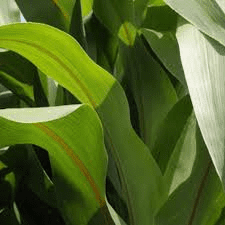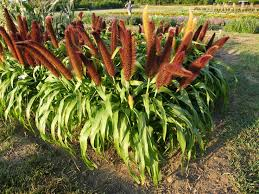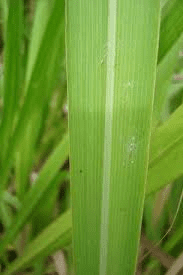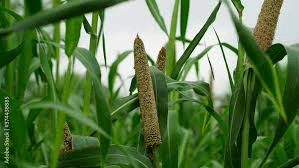Millet leaves are an essential part of the millet plant, contributing significantly to its overall health and productivity. These leaves, like those of other grasses, are typically long, slender, and green. They play a vital role in the plant’s photosynthesis process, converting sunlight into energy necessary for growth and seed production. Millet is a group of small-seeded grasses, and the leaves vary slightly in shape and size depending on the specific type of millet, such as pearl millet, foxtail millet, proso millet, and finger millet.
The primary function of millet leaves is to capture sunlight and carry out photosynthesis. This process involves using sunlight to convert carbon dioxide and water into glucose, a type of sugar that provides energy for the plant, and oxygen, which is released into the atmosphere. The efficiency of this process is crucial for the development of healthy millet seeds, which are harvested as a food source. The leaves’ large surface area and green chlorophyll pigments make them highly effective at absorbing sunlight.
Beyond their role in photosynthesis, millet leaves have several other uses and benefits. In agricultural settings, they can be used as fodder for livestock. After the seeds are harvested, the remaining plant material, including the leaves, is often dried and stored as feed. Millet leaves provide essential nutrients and fiber, contributing to the overall health and productivity of animals. This practice is particularly important in regions where other sources of animal feed might be scarce.
Millet leaves also play a role in maintaining soil health. When the leaves and other plant residues are left in the field after harvest, they decompose and add organic matter to the soil. This organic matter improves soil structure, fertility, and moisture retention. Additionally, the decomposing leaves help promote the growth of beneficial soil microorganisms, which contribute to nutrient cycling and overall soil health. This process, known as green manuring, is an important component of sustainable farming practices.
In traditional medicine, millet leaves have been used in various cultures for their potential health benefits. While scientific research on the medicinal properties of millet leaves is limited, they are often used in folk remedies for treating minor ailments and promoting general well-being. For example, in some cultures, millet leaves are brewed into teas or used to make poultices for their potential anti-inflammatory and soothing effects.
Millet leaves also have potential uses in environmental sustainability. Researchers are exploring ways to utilize millet leaves and other agricultural residues in the production of biofuels. By converting these leaves into renewable energy sources, it is possible to reduce reliance on fossil fuels and lower greenhouse gas emissions. Additionally, the fibers from millet leaves can be used to create biodegradable materials, offering an eco-friendly alternative to traditional plastics.
In some regions, millet leaves are used in culinary applications. They can be cooked and consumed as leafy greens, providing a source of vitamins and minerals. The young, tender leaves are often preferred for cooking, as they are less fibrous and have a milder flavor. Millet leaves can be added to soups, stews, and salads, enhancing the nutritional content of these dishes.
Millet leaves are a vital part of the millet plant, contributing to its growth and productivity through photosynthesis. They also have multiple uses, including as animal fodder, soil enhancers, traditional medicine, renewable energy sources, and even in culinary applications.
The versatility and utility of millet leaves make them an important resource in many parts of the world, particularly in regions where millet is a staple crop. As research continues to uncover new applications for millet leaves, their significance in agriculture, sustainability, and health is likely to expand.
The Economic Importance and Uses of Millet Leaves

1. Animal Feed: Millet leaves are used as fodder for livestock, providing essential nutrients for cattle, sheep, and goats. Farmers often chop and mix them with other feed.
2. Green Manure: Millet leaves are used as green manure to enrich the soil with organic matter and nutrients, promoting soil health and fertility.
3. Mulching: Millet leaves are used as mulch to cover the soil, helping to retain moisture, suppress weeds, and regulate soil temperature.
4. Compost: Millet leaves decompose quickly and are an excellent addition to compost piles, contributing to nutrient-rich compost for gardens and crops.
5. Medicinal Uses: In some traditional medicines, millet leaves are used to treat ailments such as digestive issues and skin conditions.
6. Organic Pesticide: Millet leaves can be used to make organic pesticides. They are boiled and sprayed on crops to deter pests and insects.
7. Livestock Bedding: Dried millet leaves are used as bedding for livestock. They are soft and absorbent, providing a comfortable resting place for animals.
8. Biofuel: Millet leaves can be processed to produce biofuel. They are fermented to produce ethanol, which is used as a renewable energy source.
9. Craft Materials: Millet leaves are used in making various handicrafts, such as mats and decorative items. They are woven or shaped into different products.
10. Natural Fiber: The fibers from millet leaves are used in making ropes and other natural fiber products, providing a sustainable alternative to synthetic fibers.
11. Erosion Control: Millet leaves are used in erosion control practices. They are spread over soil to prevent erosion and promote water retention.
12. Animal Health: Millet leaves are sometimes used in veterinary medicine to promote the health of livestock. They are included in herbal remedies for animals.
13. Soil Amendment: Millet leaves, when decomposed, act as a soil amendment, adding organic matter and improving soil structure and fertility.
14. Biogas Production: Millet leaves can be used in biogas production. They are anaerobically digested to produce methane, which can be used as a renewable energy source.
15. Biomass Energy: Millet leaves are used as a source of biomass energy. They are burned to produce heat and electricity.
16. Handicrafts: Millet leaves are used to make various handicrafts such as baskets and mats. Artisans weave and shape the leaves into different items.
17. Traditional Cooking: In some cultures, millet leaves are used in traditional cooking. They are wrapped around food and cooked to impart flavor and nutrients.
18. Eco-friendly Packaging: Millet leaves are used as eco-friendly packaging material. They are biodegradable and provide a sustainable alternative to plastic.
Read Also: The Health Benefits of Rosemary Herb
The Products and By-products That Can Be Derived From Millet Leaves

1. Animal Feed: Millet leaves are chopped and used as nutritious fodder for livestock. The leaves provide essential nutrients for animal growth and health.
2. Green Manure: Millet leaves are plowed back into the soil as green manure, enriching the soil with organic matter and nutrients.
3. Compost: Millet leaves are added to compost piles, where they decompose and form nutrient-rich compost for gardening and farming.
4. Biofuel: Millet leaves are processed to produce biofuel, particularly ethanol. The leaves are fermented to extract alcohol, which is then distilled.
5. Mulch: Millet leaves are spread over the soil as mulch, helping to retain moisture, suppress weeds, and regulate soil temperature.
6. Medicinal Products: Millet leaves are used to make traditional medicinal products. They are processed into extracts, teas, and poultices for various treatments.
7. Organic Pesticides: Millet leaves are boiled and the resulting liquid is used as an organic pesticide to protect crops from pests and insects.
8. Craft Materials: Millet leaves are woven into baskets, mats, and other handicrafts. The leaves are processed and shaped into various items.
9. Natural Fiber: The fibers from millet leaves are extracted and used to make ropes and other natural fiber products.
10. Erosion Control: Millet leaves are used in erosion control measures. They are spread over the soil to prevent erosion and improve water retention.
11. Livestock Bedding: Dried millet leaves are used as bedding material for livestock, providing a soft and absorbent surface.
12. Biogas: Millet leaves are used in biogas production. They are anaerobically digested to produce methane, which is used as a renewable energy source.
13. Biomass Energy: Millet leaves are burned as biomass to produce heat and electricity, providing a renewable energy source.
14. Traditional Cooking: Millet leaves are used in traditional cooking methods. They are wrapped around food and cooked to add flavor and nutrients.
15. Soil Amendment: Decomposed millet leaves are used as a soil amendment, adding organic matter and improving soil structure.
16. Veterinary Medicine: Millet leaves are used in veterinary medicine to promote the health of livestock. They are included in herbal remedies for animals.
17. Eco-friendly Packaging: Millet leaves are used as biodegradable packaging material, providing a sustainable alternative to plastic.
Read Also: Definition of Water and Wind Erosion
Frequently Asked Questions (FAQ’s) About Millet Leaves

1. What are millet leaves?
Millet leaves are the green foliage of millet plants, used in various agricultural and industrial applications.
2. How are millet leaves used in agriculture?
Millet leaves are used as animal feed, green manure, mulch, and compost in agricultural practices.
3. Can millet leaves be used as biofuel?
Yes, millet leaves can be processed to produce biofuel, particularly ethanol.
4. What are the benefits of using millet leaves as mulch?
Using millet leaves as mulch helps retain soil moisture, suppress weeds, and regulate soil temperature.
5. How do millet leaves contribute to soil fertility?
Millet leaves decompose to add organic matter and nutrients to the soil, improving its fertility and structure.
6. Are millet leaves used in traditional medicine?
Yes, millet leaves are used in traditional medicine to treat ailments such as digestive issues and skin conditions.
7. Can millet leaves be used in craft making?
Yes, millet leaves are used to make various handicrafts, such as baskets and mats.
8. How do millet leaves help in erosion control?
Millet leaves are spread over soil to prevent erosion and improve water retention.
9. Are millet leaves used in animal bedding?
Yes, dried millet leaves are used as soft and absorbent bedding material for livestock.
10. Can millet leaves be used for biogas production?
Yes, millet leaves can be anaerobically digested to produce methane, which is used as a renewable energy source.






